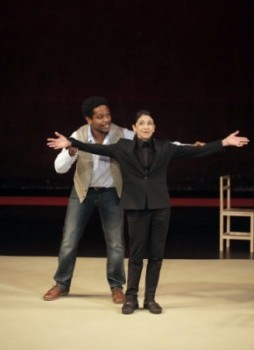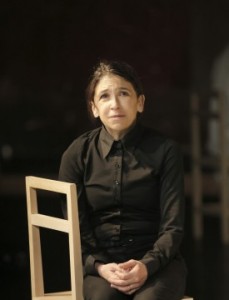
Jared McNeill and Kathryn Hunter explore rather unusual properties of the human brain in THE VALLEY OF ASTONISHMENT (photo by Pascal Victor / ArtComArt)
Theatre for a New Audience, Polonsky Shakespeare Center
262 Ashland Pl. between Lafayette Ave. & Fulton St.
Tuesday – Sunday through October 5, $60-$75
866-811-4111
www.tfana.org
The Valley of Astonishment, a fascinating, often thoroughly entrancing tale that delves into the magical mysteries of the human brain, comes from the endlessly creative minds of Peter Brook and Marie-Hélène Estienne and their C.I.C.T. / Théâtre des Bouffes du Nord company. The spare, eighty-minute production, running at Theatre for a New Audience through October 5, evokes elements of their previous works The Conference of the Birds, based on the twelfth-century poem by Farid ud-Din Attar, and The Man Who, inspired by Oliver Sacks’s The Man Who Mistook His Wife for a Hat, while going to new, exciting places. The great Kathryn Hunter (Brook and Estienne’s Fragments, The Bee) plays Samy Costas, a character inspired by the real-life Russian mnemonist Solomon Shereshevsky; Samy is a rather ordinary woman except that she has an extraordinary memory, able to recall everything that anyone has ever said to her through synesthesia, a process in which she associates words with images. Theatre de Complicité cofounding member Marcello Magni (Fragments with Hunter, The Birds directed by Hunter) portrays one of the scientists who studies Samy; a man with no proprioception who has to use his brain a special way in order to move his otherwise paralyzed body; and a one-armed magician inspired by René Lavand. And Jared McNeill (Brook and Estienne’s The Suit, Life of Galileo) plays a second scientist; a music-hall impresario; and a painter who sees colors when he listens to jazz. The live score is performed by composer and pianist Raphaël Chambouvet and Toshi Tsuchitori on strings and percussion; each man also takes his turn at center stage.

Kathryn Hunter is once again astonishing in Peter Brook / Marie-Hélène Estienne production (photo by Pascal Victor / ArtComArt)
The scenes that explore the blessing/curse of synesthesia are dazzling; Hunter is delightfully mesmerizing, Magni is superb as the man relearning how to walk, and McNeill excels as he imagines painting a canvas on the floor, with the help of lighting designer Philippe Vialatte. (The set includes several unpainted chairs, a rolling desk, and a coatrack, with the musicians off to one side.) One of the scientists refers to Samy’s ability as “tricks,” and soon Brook and Estienne (Je suis un Phénomène, Woza Albert!) give the show over to the one-armed magician, who performs card tricks for some of the other characters as well as a pair of audience members pulled onstage. While the tricks are cool, the scene goes on far too long and appears relevant only in its final moment, by which time the narrative thread has nearly been lost. However, it does come together for a moving finale, especially as Samy grapples with the possibility that her unique powers might be reaching an end. The Valley of Astonishment is, at times, indeed astonishing, an intelligent yet playful exploration of some of the wondrous capabilities of the human brain and how supposed experts react to them, turning them into sideshow attractions rather than using them for a greater purpose. In conjunction with the show, TFANA is hosting “Celebrating Peter Brook,” a two-day film series honoring the eighty-nine-year-old writer, director, and author, consisting of screenings of son Simon Brook’s 2012 documentary Peter Brook: The Tightrope (followed by a Q&A with Simon) and 2002 doc Brook by Brook on September 29 and Peter’s 1968 film Tell Me Lies (introduced by Simon) on September 30.